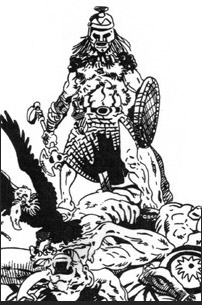“What goes when on a fighter? I’m 25 and I’m wondering what road bumps are ahead in terms of losing ability at natural rates and other pitfalls.”
-Heath
Generalities
Shoulder injuries are the ground floor biomechanical failure, since it is a half enclosed joint and so many ball sports use it up in the teens, with some fighters, such as myself, developing serious shoulder problems in their late teens.
Most fighters begin having trouble making their 18-year-old weight between 23-27, depending on their metabolism and how young they matured.
Between 27-33 two things tend to crop up on combat athletes:
Entry into a higher than optimal weight class,
And lower back injuries, due to wear and tear and twisting in grappling, and the non-bilateral body mechanics of punching, which cause problems with the lower back.
My Experience
All of the above came true for me, plus I have noted the following measures of decrepitude in my extended fighting activities, as most men finish in their mid-thirties when I began again at 35, having been side-lined by injuries between 27 and 32. These are all in the general decline category, not due to injuries from getting hit, like ribs and jaw.
35-40: if the ankles haven’t been torn yet, they’re due. Be careful skipping rope and avoid ball sports. If you haven’t needed glasses you might find yourself getting headaches while reading. The warrantee has run out on your body.
41 to 43, for me was a second youth, having learned to manage the back, shoulder and ankle injuries and able to improve technique and integrate skills I hadn’t picked up the first time around.
45 I saw a slowing in my metabolism, upping my weight again and putting my neck in danger.
46-49: My hands slowed but I was able to increase power and gained 2 inches on my forearms.
50-56: My hands did not slow any more, but my reflexes, my ability to pick up movement headed my way diminished dangerously. My eyes got much worse. More weight gain made competition too dangerous for my neck.
That said, I have not lost timing, skill, rhythm or power at all due to aging. Though my body is not robust enough to compete with men in their prime who have picked up enough skill and timing to deal with my advantages, I can still deal with spry novices easily with weapons, but with boxing, I can’t take the punches anymore because of my weight gain. I have not mentioned strength because I have never been strong, but what little strength I entered adulthood with I have maintained into my mid-50s.
A heavier body anchors your neck to more mass and a guy like me that could take heavyweight punched to the head at 143 will get hurt eating lightweight punches at 200. In fact, over half of my 20 odd concussions happened in my late 40s.
Winter of a Fighting Life: A Kinetic Memoir











I've definitely noticed a slow-down in my metabolism starting around age 30, and as I have always been on the heavy side, I pick up weight very easily anymore. I have had some success with switching to pure black coffee and eliminating sugar and junk everywhere I can, as well as lowering my carb intake from where it was (just sitting around grazing on chips all day), but it had been a slow road back to where I was around 2010-2011.
"How the Fighter Ages"
Badly.
As the saying goes, "Thanks to all my continual high-level training, I'm going to be world's most dangerous cripple at age 50."
Not that I have any qualification for input on this one (James can vouch I am no sort of fighter at all), but I couldn't resist.
Yes, fighters age badly.